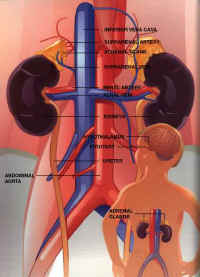Adrenal Glands
 The adrenals are two small glands that are located in the abdomen on top of each kidney. These glands produce chemical messengers called hormones that affect many cells of the body.
The adrenals are two small glands that are located in the abdomen on top of each kidney. These glands produce chemical messengers called hormones that affect many cells of the body.
The adrenal glands release hormones that help the body react to danger. The heart pumps faster and blood pressure rises. The rate of metabolism increases for extra energy. These changes enable a person to think and act faster.
In response to signals from the pituitary gland in the brain, the adrenal glands produce many other hormones. These hormones are natural steroids including the hormone, cortisone, that the body makes from cholesterol. Adrenal hormones help to balance fluid in the body and work with other hormones to make sure the body has enough energy and can react to stress such as illness or injury. The adrenal glands also make small amounts of hormones that affect sexual development and growth.
When things go wrong
Normally, a feedback system keeps hormones well regulated. A high amount of hormone in the blood sends a signal back to the gland to make less. When the hormone level in the blood drops, the feedback decreases, allowing the gland to begin making more hormone.
Too much of the adrenal hormones can cause a number of problems. An example is the condition known as Cushings disease, which is due to a pituitary gland problem. The typical appearance is short stature, a rounded face, heavy abdomen with thin legs, and fat deposits on the upper back. Menstrual periods may be absent or infrequent. Acne, excess hair growth and clitoromegaly, enlargement of the female genitals, may occur. Over time this condition can lead to other problems such as osteoporosis, high blood pressure, and diabetes.
A lack of adrenal hormones may cause weakness and fatigue, weight loss, nausea and vomiting, joint and muscle pain, and loss of body hair. It may be due to a pituitary gland problem or can occur following stress such as injury, infection, or surgery. Sometimes, a lack of adrenal hormones is due to a problem with the immune system. This is commonly called Addisons disease.
Correcting hormone imbalance
Fortunately, hormone imbalances can often be corrected. Hormone levels that are low can be brought up to normal with synthetic hormones that work just like the ones the body makes naturally. Hormone levels that are too high may be treated with drugs or with other hormones that have an opposite effect. Adrenal glands can also be removed surgically or treated with radiation.
Special considerations
Patients with low adrenal hormones must be sure to take replacement hormones every day. Failure to do so can result in a life-threatening situation requiring emergency medical treatment. Also, during times of illness, fever, or stress, doses of replacement hormones must be increased to meet the demands of the body. In children, normal growth may be affected, resulting in problems with self-esteem and behavior.
It is best to have regular care from medical professionals who specialize in disorders of the endocrine system. They can provide, medical care, information, practical advice, and help with emotional and social concerns.
Adrenal glands
- Glands are located at the top of the kidneys
- The center of the gland is the adrenal medulla
- The outer section is the adrenal cortex
- Each portion functions separately to help regulate glucose and fluid metabolism and deal with physical and emotional stress
Adrenal medulla responds to the nervous system
- Helps the body deal with emergency situations
- Increases blood supply to the brain, muscles, and heart
- Increases heart rate
- Enlarges airways for more effective breathing
- Raises blood glucose and fatty acid levels for extra energy
- Epinephrine (adrenaline) – increases blood pressure by increasing cardiac output
- Norepinephrine (noradrenaline) – increases blood pressure by constricting blood vessels
Adrenal cortex is stimulated by ACTH from the pituitary gland
- Hormones produced are steroids with various essential functions
- Cortisol (hydrocortisone) – helps the liver make glucose from sources other than carbohydrates
- Aldosterone – helps maintain fluid balance by adjusting sodium and potassium levels
- Androgens and Estrogens – sex hormones that influence sexual development and growth in both males and females
Disorders and clinical features
Acute adrenal insufficiency (adrenal crisis)
-
-
- Weakness, abdominal pain, fever, nausea, vomiting
- Low BP, dehydration
- High serum potassium
-
Adrenal hyperplasia (congenital or late onset)
-
-
- Defect in adrenal gland metabolism (congenital)
- Abnormal puberty or sexual development
- Ambiguous genitalia or clitoromegaly
- Inability to produce normal amounts of cortisol and alclosterone
-
Chronic adrenal insufficiency (Addisons disease destruction of adrenal glands)
-
-
- Weakness, weight loss, anorexia, nausea, and vomiting
- Hyperpigmentation (darkening of axillae, groin, buccal and vaginal mucosa, nipples, creases of hands)
- Joint and muscle pain
- Sparse axillary/pubic hair
-
Adrenal cortical hypersecretion (Cushing syndrome)
-
-
- Rounded, moon face
- Accumulation of fat on upper back and trunk
- Muscle wasting
- Purple striae, easy bruising, delayed healing
- Osteoporosis, hypertension, diabetes
- Psychiatric symptoms
-
Idiopathic hirsutism and virilization
-
-
- Menstrual disorders
- Acne
- Increased muscle mass, deepening of voice
- Clitoromegaly
-
Primary hyperalclosteronism
-
-
- Hypertension, polyuria, polyclipsia, muscle weakness
- Hypokalemia,alkalosis
- Elevated alclosterone level and low renin level
-
